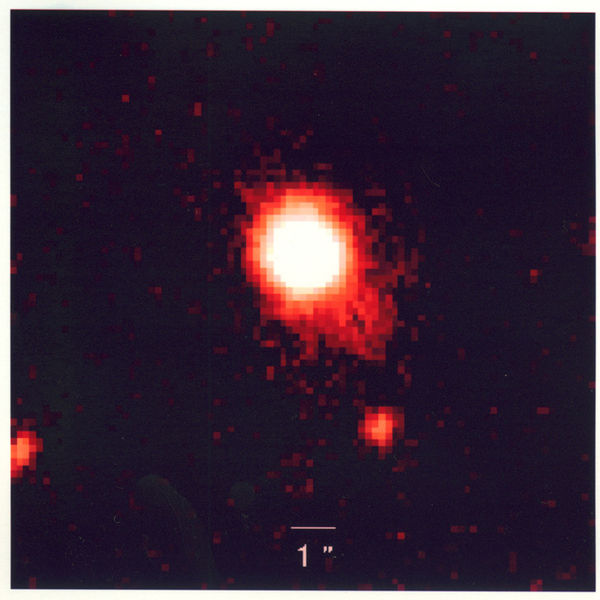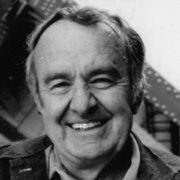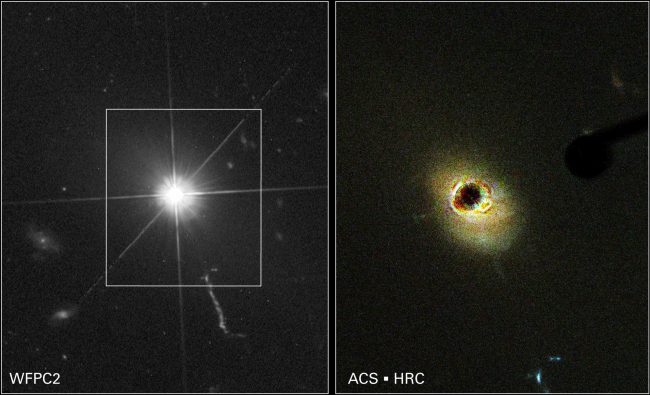
Quasar Burst
On June 18, 1926, American astronomer Allan Rex Sandage was born. Sandage determined the first reasonably accurate values for the Hubble constant and the age of the universe. Foremost, he is also credited with the discovery of the 3C 48 quasar, i.e. quasi-stellar radio sources which are the most energetic and distant members of a class of objects called active galactic nuclei.
The Discovery of Quasars
Between 1917 and 1922, it became clear from work by Heber Curtis, Ernst Öpik and others, that some objects (“nebulae”) seen by astronomers were in fact distant galaxies like our own. But when radio astronomy began in the 1950s, astronomers detected, among the galaxies, a small number of anomalous objects with properties that defied explanation. It is believed that the first quasars were probably detected in the later 1950s, as radio sources in all-sky radio surveys. 3C 48 and 3C 273 were first noted as radio sources with no corresponding visible object. With small telescopes and the Lovell Telescope as an interferometer the quasars were shown to have a very small angular size. By 1960, hundreds of these objects were recorded by 1960 and published in the Third Cambridge Catalogue as astronomers scanned the skies for their optical counterparts.

Allan Rex Sandage (1926 – 2010)
The Definite Identification
In 1963, a definite identification of the radio source 3C 48 with an optical object was published by the scientists Allan Sandage and Thomas A. Matthews. Astronomers had detected what appeared to be a faint blue star at the location of the radio source and obtained its spectrum. Containing many unknown broad emission lines, the anomalous spectrum defied interpretation — a claim by John Bolton of a large redshift was not generally accepted. Considerable discussion took place over what these objects might be. They were described as “quasi-stellar [meaning: star-like] radio sources”, or “quasi-stellar objects” (QSOs), a name which reflected their unknown nature, and this became shortened to “quasar”.

Hubble images of quasar 3C 273. At right, a coronagraph is used to block the quasar’s light, making it easier to detect the surrounding host galaxy.
The Term Quasar
The term “quasar” was coined by Chinese-born U.S. astrophysicist Hong-Yee Chiu in May 1964, in Physics Today, to describe certain astronomically-puzzling objects:
“So far, the clumsily long name ‘quasi-stellar radio sources’ is used to describe these objects. Because the nature of these objects is entirely unknown, it is hard to prepare a short, appropriate nomenclature for them so that their essential properties are obvious from their name. For convenience, the abbreviated form ‘quasar’ will be used throughout this paper.”
A quasar is the active nucleus of a galaxy that appears nearly point-like in visible light (like a star) and emits very large amounts of energy in other wavelength ranges. Since quasars appear relatively bright despite their great distance, they are among the most luminous objects in the universe. Only very briefly bright phenomena (supernova, gamma-ray flash) may be more energetic. Quasars are bright over wide ranges of electromagnetic radiation and have characteristic spectra with very broad emission lines indicating gas in rapid motion. The luminous matter orbits the galactic nucleus at high speed, and as it does so, the part of the matter moving away from the observer experiences a redshift and the part moving toward the observer experiences a blueshift. Overall, this causes the spectral lines to broaden. Photometrically, therefore, quasars can be distinguished from a star by the very broad spectral lines.
A Student of Hubble
Alan Sandage is considered as one of the most influential astronomers of the 20th century. He attended the University of Illinois and graduated in 1948. Sandage received his Ph.D. from the California Institute of Technology in 1953 with a thesis on the globular cluster Messier 3. Back then, Sandage was also a graduate student assistant to cosmologist Edwin Hubble.[4] Alan Sandage continued Hubble’s research program after the latter’s death in 1953. Throughout the 1950s and well into the 1980s Sandage was regarded as the pre-eminent observational cosmologist, making contributions to all aspects of the cosmological distance scale, ranging from calibrators within our own Milky Way galaxy, to cosmologically distant galaxies.
The First Good Estimate of the Hubble Constant
From 1952 he worked at the Mount Wilson and Palomar Observatories (now the Observatory of the Carnegie Institution of Washington) in Pasadena. In 1958 he published the first good estimate for the Hubble constant, revising Hubble’s value of 250 down to 75 km/s/Mpc, which is close to today’s accepted value . Furthermore, Sandage performed photometric studies of globular clusters, and calculated their age to be at least 25 billion years. This led him to speculate that the universe did not merely expand, but actually expanded and contracted with a period of 80 billion years. The current cosmological estimates of the age of the universe, in contrast, are typically of the order of 14 billion years. As part of his studies concerning the formation of galaxies in the early universe, he co-wrote a paper along with Olin J. Eggen, and Donald Lynden-Bell, first describing the collapse of a proto-galactic gas cloud into our present Milky Way galaxy.
An Influencer to Observational Cosmology
In his 1961 paper “The Ability of the 200-inch Telescope to Discriminate Between Selected World Models,” he suggested that the future of observational cosmology would be the search for two parameters: the Hubble constant H0 and the deceleration parameter q0. This paper influenced observational cosmology for at least three decades as it carefully specified the types of observational tests that could be performed with a large telescope. He also published two atlases of galaxies (Hubble Atlas of Galaxies), in 1961 and 1981, based on the Hubble classification scheme. In 1962 Sandage studied the possibility of directly measuring the temporal variation of the redshift of extra-galactic sources. This analysis became known as the Sandage–Loeb test. In addition, he discovered an asteroid, and two comets have also been named Sandage.
On November 13, 2010, Sandage died of pancreatic cancer at age 84.
Quasars: the Brightest Black Holes – Professor Carolin Crawford, [8]
References and Further Reading:
- [1] Alan Sandage at Britannica
- [2] Short Biography and Work of Alan Sandage
- [3] Research Shedss New Light on Quasars
- [4] The Universe goes beyond the Milky Way – Edwin Hubble contributions to Astronomy, SciHi Blog
- [5] Alan Sandage at Wikidata
- [6] Allan Sandage: Astronomer widely acknowledged as among the most outstanding of the 20th century, The Independent Obituary, 22 November 2010
- [7] Rowan-Robinson, Michael (2011). “Obituaries: Allan Rex Sandage”. Physics Today. 64 (6): 64–65.
- [8] Quasars: the Brightest Black Holes – Professor Carolin Crawford, Gresham College @ youtube
[9] Schmidt Maarten (1963). “3C 273: a star-like object with large red-shift”. Nature. 197 (4872): 1040. - [10] Matthews, Thomas A.; Sandage, Allan R. (1963). “Optical Identification of 3c 48, 3c 196, and 3c 286 with Stellar Objects”. Astrophysical Journal. 138: 30–56.
- [11] J. Greenstein; M. Schmidt (1964). “The Quasi-Stellar Radio Sources 3C 48 and 3C”. Astrophysical Journal. 140 (1): 1–34.
- [12] Timeline of Cosmologists, via DBpedia and Wikidata





